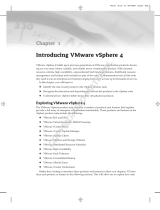
47DELL.COM/PowerSolutions
Reprinted from
Dell Power Solutions,
September 2009. Copyright © 2009 Dell Inc. All rights reserved.
restores from disk and can negatively
affect service-level agreements (SLAs).
Legacy backup software places a clear
emphasis on the backup process, generally
ignoring factors that contribute to scalability,
resiliency, and operational efficiencies. Next-
generation tools such as the CommVault
Simpana Universal Virtual Server Agent
(UVSA) provide a slew of advanced capabili-
ties including automatic discovery, multi-
streaming for concurrency, resiliency
controls, incremental backup and deduplica-
tion for disk efficiency and rapid recovery,
extended data retention and recovery
options such as granular restore without
restaging, and cross-platform restore. The
UVSA is designed from the ground up to
ease operational overhead for administra-
tors; automate mundane, day-to-day tasks;
and allow crucial resources to focus on busi-
ness problems while providing extended
disk-based retention and rapid restore capa-
bilities to help meet aggressive SLAs.
CONFIGURING ROBUST
BACKUP PROCESSES
In large environments, it is common for VMs
to “float” across physical servers using
advanced capabilities such as VMware
vMotion
™
technology, VMware High
Availability (HA), and VMware Distributed
Resource Scheduler (DRS). Integration with
VMware vCenter
™
Server (formerly VMware
VirtualCenter) enables administrators to
enumerate VMs as well as the VMware ESX
servers and data stores hosting them.
Many backup solutions can integrate
with vCenter Server during the initial backup
policy configuration to locate and list exist-
ing VMs. In addition, however, the CommVault
Simpana UVSA incorporates features such
as automatic VM discovery to automatically
assign new VMs to backup policies, backup
process offloading, multiple backup options,
and multi-streaming to help optimize back-
ups in virtualized environments.
Automatic VM discovery
In large environments, new VMs can be
added to the virtualized infrastructure almost
daily, often outside the control of data pro-
tection administrators. Without automated
tools, these administrators are left to manu-
ally hunt down new VMs and add them to
the appropriate backup policy—a process
that is both time-consuming and error-
prone, potentially leaving VMs backed up
multiple times or (worse) not at all.
The UVSA supports automatic VM dis-
covery to automatically assign new VMs to
backup policies based on predefined rules.
Administrators create an initial set of backup
policies based on desired protection levels,
with discovery rules then applied that asso-
ciate VMs with an appropriate backup
policy. The discovery rules need to be
defined only once, during the initial setup.
Backup process offloading
VMs are typically configured to balance
and maximize physical server resource
utilization for regular application work-
loads. A traditional backup model using
an agent in every VM can quickly desta-
bilize this balance. Scheduled simultane-
ous backups on VMs can consume all
available ESX server resources, over-
whelming the physical infrastructure and
slowing production systems to a crawl.
While all VCB-based data protection
tools benefit from some built-in VCB
capabilities, VCB does have scalability
constraints—and many ungoverned simul-
taneous VCB snapshot requests can cause
failures that then lead to delayed or failed
backups. The UVSA includes built-in con-
trols designed to streamline simultaneous
VCB snapshot requests and dramatically
increase scalability and resiliency, even in
very large environments.
Multiple backup options
VCB-based data protection tools typically
require two backup policies for each VM:
image-level backups for disaster recovery
and file-level backups for granular recov-
ery. However, this approach typically
doubles the number of backups, increases
storage requirements, and complicates
recovery by requiring administrators to
track two backup sets for each VM.
The UVSA offers three backup options
to help balance disaster recovery with
granular recovery and to help meet disk
retention and recovery needs:
Disk-level backup:
■■
This option backs up
the full VM image, moving only the occu-
pied portions of a VM image. (For exam-
ple, for a VM image that is provisioned
at 20 GB but consumes only 10 GB of
space, the UVSA backs up only 10 GB.)
Files and folders are indexed during
backup, allowing granular recovery from
an image backup. In addition, true block-
level incremental (BLI) capability backs
up only changed extents of a VM image,
helping limit the amount of data that
must be transferred and stored.
File-level backup:
■■
This option enables
backup of individual files within a VM. A
separate file-level backup policy is useful
when administrators need to separately
retain both a disaster recovery copy and
a subset of files in the VM. In addition,
the ability to index files inside the VM
also makes it available for search and
e-discovery—a key capability as an
increasing amount of critical enterprise
data shifts to VMs, given that other
e-discovery solutions typically require
agents inside VMs that then complicate
deployment, management, search, and
discovery processes.
Volume-level backup:
■■
This hybrid
option takes advantage of the VCB file-
level backup mode to mount the file
system instead of copying the full
image over, and then backs up blocks
of the file systems for an image-like
backup. Recovery options include the
ability to restore individual partitions to
either a physical system or a VM run-
ning on VMware or Microsoft Hyper-V
™
platforms. This option also supports
BLI backup.
Multi-streaming
VM proliferation can stretch the limits
of already-shrinking backup operating win-
dows—and sequential VM backup process-
ing combined with full image processing of





